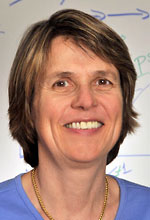Featured Stories | March 12, 2014
PBS NewsHour Spotlights Penny Chisholm’s Phytoplankton Work
By Genevieve Wanucha
PBS NewsHour recently visited oceanographer Penny Chisholm at MIT and made this great video about her life’s work with an ocean-dwelling organism called Prochlorococcus, the tiny green cells that number a “billion billion billion” in the ocean — that’s 1,000,000,000,000,000,000,000,000,000. About 3.5 billion years ago, their ancestors evolved the capacity to photosynthesize, which essentially built the oxygenated atmosphere that we enjoy today.
Take a look as the video camera follows Chisholm in a brightly lit temperature-controlled room, filled with vials of Prochlorococcus from all over the world, while she explains how these “little greens” are at the center of a basic research discovery that is profoundly changing the way scientists think about and model the carbon cycle.
Video by Rebecca Jacobson. Additional video courtesy Eric Grabowski, NSF Center for Microbial Oceanography: Research and Education. Images courtesy Chisholm Lab, MIT.
Further Information
 Read the Oceans at MIT feature story on the Chisholm lab, ‘Little Greens’ in the Age of Marine Genomics.
Read the Oceans at MIT feature story on the Chisholm lab, ‘Little Greens’ in the Age of Marine Genomics.
 To spread the word to all ages, Chisholm and writer/illustrator Molly Bang have written children’s books, “Living Sunlight: How Plants Bring Earth to Life” and “Ocean Sunlight: How Tiny Plants Feed the Seas.”
To spread the word to all ages, Chisholm and writer/illustrator Molly Bang have written children’s books, “Living Sunlight: How Plants Bring Earth to Life” and “Ocean Sunlight: How Tiny Plants Feed the Seas.”
 Chisholm’s Prochlorococcus Portal, a resource for learning everything about the microbe
Chisholm’s Prochlorococcus Portal, a resource for learning everything about the microbe
 C&EN article in which Chisholm discusses the benefits of public outreach and writing children’s science books.
C&EN article in which Chisholm discusses the benefits of public outreach and writing children’s science books.





